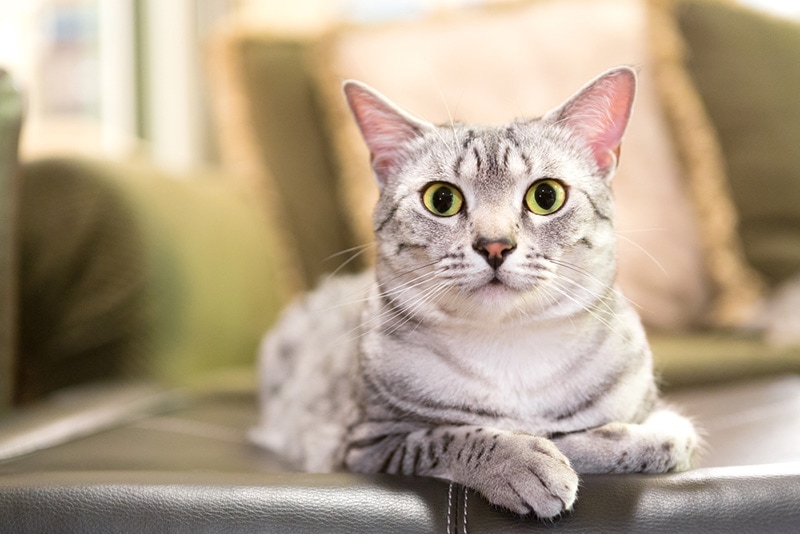Cat Pupils: Vet-Approved Guide to What Their Eyes Are Telling You (With Pictures)
By Jessica Kim
Updated on

While your cat may not be able to have a verbal conversation with you, they can still speak to you in many ways. You can gather a lot of information by paying attention to their body language and other subtle cues. One of the ways that cats can communicate is through their eyes. A cat’s pupils can change shape and size depending on their emotional status or because of an underlying eye problem. By paying attention and familiarizing yourself with cat body language and behavior, you can learn to read your cat through their eyes.
There are situations in which a cat’s pupils change size or even shape because of an underlying medical condition. In these situations, a trip to the vet is necessary to understand what is happening and to check if your cat needs further tests to reach a diagnosis. The two main situations you may encounter are if your cat’s pupils are uneven or if your cat’s pupils remain dilated despite them being under bright light conditions and with no external stimuli that justifies this change.
The Cat Pupil Guide
1. Dilated Pupils

A cat’s pupils can dilate depending on their mood. Dilated pupils usually mean that a cat feels alert, and something is capturing their attention or interest. They can also indicate that a cat feels excited, angry, or fearful.
Dilated pupils can enlarge to look like saucers. Saucer-shaped eyes usually mean that a cat feels overexcited or overstimulated. If this is the case, it’s important to give your cat space and remain calm to help your cat come down from a heightened emotional state and feel relaxed. You can also tell that a cat is angry by paying attention to other body language and cues. They can start to growl or yowl and flick their tail. They may also arch their back or raise and fluff their tails as a means of trying to appear bigger. Once your cat calms down, the pupils should return to a normal size.
2. Narrowed Pupils

When a cat’s pupils narrow, they look like vertical slits. This is usually the default appearance for a happy and content cat. Most cats that feel happy will also purr, and their bodies will be loose and relaxed. If they’re looking at you, they’ll give you a soft, affectionate stare.
Happy cats can also rub against you or want to cuddle with you. If they feel comfortable around you, they can knead or “make biscuits” with their front paws.
3. Constricted Pupils

While happy cats often have slightly narrowed pupils, completely constricted pupils do not indicate any changes in mood but that your cat’s pupils are reacting to bright light conditions.
This is called the pupillary light reflex, and it is controlled by the retina, the iris, and the nervous system. The retina, located at the back of the eye, sends the information. This is easily seen if you shine a light to your cat’s eyes. In normal conditions, your cat’s pupils will constrict to a thin, vertical line.
4. Half-Closed Eyes

Cats staring at you with eyes half closed are often feeling very relaxed around you. They feel at peace and are probably getting themselves ready for a nice long cat nap. Relaxed cats will also have slow and steady breathing, and their tails will be upright if they’re standing.
It’s best to leave your cat undisturbed if their eyes are half-closed. They may be feeling sleepy and won’t welcome sudden interruptions.
5. Slow Blink

A slow blink from a cat is one of the highest compliments you can receive from them. It’s a sign that the cat trusts you and feels affection towards you. You can also return the love by giving them a slow blink.
Cats usually give a slow blink when they’re feeling calm and relaxed. So, don’t expect them to slow blink when they’re feeling playful or excited.
6. Possible Health Issues

Your cat’s pupils can also give you information about their health because they can indicate an underlying medical issue. For example, unevenly sized pupils can be a condition known as anisocoria. Anisocoria can be caused by glaucoma, uveitis, retinal disease, and certain infectious diseases.
If something seems off about your cat’s eyes or pupils, make sure to contact your veterinarian right away. Some cases may indicate a serious health issue that requires immediate medical attention. It’ll also be helpful for both you and your veterinarian to document any other possible signs of illness, such as red eyes, squinting, discharge, or cloudy eyes.
How to Read Your Cat’s Eyes Accurately
It’s going to take some time to read your cat’s eyes with accuracy. One of the best ways to know what your cat is telling you through their eyes is to observe your cat intentionally and look for context clues.
So, spend some time paying attention to your cat throughout the day. Familiarize yourself with what their pupils look like whenever they’re relaxing or playing. Make sure to pair any other body language and behavioral cues with specific activities that your cat engages in. Check to see how they position their body and their ears, what their tail is doing, and if they’re making any sounds.
Gathering these clues will eventually help you to piece together specific and unique ways that your cat expresses their emotions.
Final Thoughts
It’s often said that the eyes are the windows to the soul, and this saying is true for cats. Your cat’s pupils and stares can help you understand how your cat is feeling. So, make sure to take some time to observe your cat and familiarize yourself with the subtle clues that they’re giving you. This will only help you to understand your cat better and give them the best possible attention and care.
Featured Image Credit: StockSnap, Pixabay












